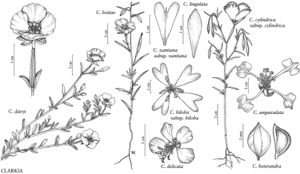familyOnagraceae
subfamilyOnagraceae subfam. Onagroideae
genusClarkia
sectionClarkia sect. Phaeostoma
subsectionClarkia subsect. Lautiflorae
speciesClarkia biloba
subspeciesClarkia biloba subsp. biloba
Difference between revisions of "Clarkia biloba subsp. biloba"
Treatment appears in FNA Volume 10.
imported>Volume Importer |
imported>Volume Importer |
||
| Line 42: | Line 42: | ||
|publication year= | |publication year= | ||
|special status= | |special status= | ||
| − | |source xml=https://xjsachs2@bitbucket.org/aafc-mbb/fna-data-curation.git/src/ | + | |source xml=https://xjsachs2@bitbucket.org/aafc-mbb/fna-data-curation.git/src/e39f0e846f172941159b2045254d62d10d9823f6/coarse_grained_fna_xml/V10/V10_407.xml |
|subfamily=Onagraceae subfam. Onagroideae | |subfamily=Onagraceae subfam. Onagroideae | ||
|tribe=Onagraceae tribe Onagreae | |tribe=Onagraceae tribe Onagreae | ||
Latest revision as of 11:32, 9 May 2022
Leaf blades narrowly lanceolate, 5–8 mm wide. Flowers: corolla rotate, petals purplish to pale pink, broadly fan-shaped, length not greater than 1.5 times width, deeply 2-lobed, lobes usually 1/5–1/2 petal length. 2n = 16.
Phenology: Flowering May–Aug.
Habitat: Foothill woodlands.
Elevation: 0–1000 m.
Discussion
Subspecies biloba is known from the central and northern Sierra Nevada Foothills, especially in Calaveras, El Dorado, and Tuolumne counties, and from the eastern San Francisco Bay area in Contra Costa County.
Selected References
None.
Lower Taxa
None.
